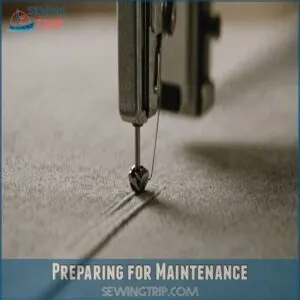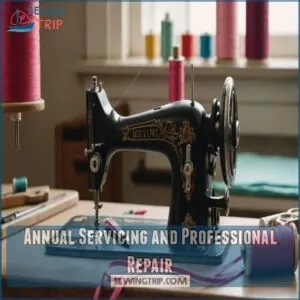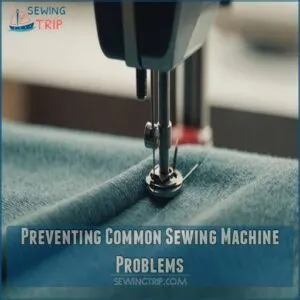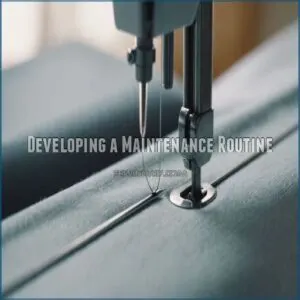This site is supported by our readers. We may earn a commission, at no cost to you, if you purchase through links.

Start with quality needle and thread—your machine will thank you.
Regular cleaning is key, but skip the canned air; it can blow lint deeper into the machine. Instead, gently brush away dust and cover it after each use.
Oiling keeps things smooth, so choose the right oil and avoid overdoing it.
Change needles frequently to avoid skipped stitches.
And for those tricky problems? A trusted expert is your backup hero.
Stay tuned for more secrets to keeping your sewing machine humming along!
Table Of Contents
Key Takeaways
- Regularly clean your sewing machine by unplugging it and using a process like how to clean a sewing machine to avoid electrical risks, with a lint brush and avoid using canned air to prevent lint from clogging the internal parts.
- Replace the needle every 8 to 10 hours of sewing to prevent skipped stitches and ensure fabric quality.
- Use high-quality sewing machine oil sparingly on moving parts as recommended in the manual to keep your machine running smoothly.
- Set up a regular maintenance routine that includes cleaning, oiling, and needle changes to prolong your machine’s lifespan and performance.
Preparing for Maintenance
Before you grab that screwdriver, set up a clean, well-lit workspace where you won’t lose any tiny screws—those things can vanish faster than your last slice of cake!
Gather essential tools like a lint brush, tweezers, and a microfiber cloth to make sure you’re ready to give your trusty sewing machine the TLC it deserves.
Essential Sewing Machine Cleaning Tools
Imagine you’re getting ready to maintain your sewing machine.
You’ll need essential tools to begin: a lint brush for those pesky fibers, tweezers for tiny threads, a small screwdriver for adjustments, and a trusty microfiber cloth and pipe cleaners to wipe away grime.
These sewing machine tools help your machine run smoothly, keeping your sewing adventures glitch-free!
Optional Tools for Deep Cleaning
For those times when your sewing machine could use a little extra love, optional deep-cleaning tools are a godsend.
Consider regular cleaning of the bobbin case and hook area for a sewing machine mini spa day, and specialized sewing machine brushes and trusty lint removal tools for tackling stubborn dust.
Compressed air helps dislodge debris from tight spots.
Add cleaning solutions and microfiber cloths for a pristine finish.
A well-maintained machine promotes smoother stitching and fewer headaches!
Setting Up a Safe Workspace
Creating a well-organized workspace is key for efficient sewing machine maintenance.
Good lighting prevents eye strain; you’ll appreciate an ergonomic setup to avoid aches.
Keep everything you need within easy reach.
Proper workspace organization minimizes safety hazards.
Regularly cleaning and oiling your sewing machine, following expert tips for pristine performance, makes sewing machine cleaning and oiling a breeze!
Safety Precautions During Sewing Machine Maintenance
Ever fumble with a sewing machine without consideration for safety? Before DIY maintenance, switch, or turn it off; you need to mind these details:
- Unplugged machine: Essential to avoid shocks.
- Wear eye protection: Keep those peepers safe.
- Handle sharp objects with care: No stitches—you’ll thank me!
- Fire safety: Keep extinguishers nearby.
- Sewing machine oil storage: Away from flames.
Proper Disposal of Sharps and Waste
You’ve got needles lying around, right? It’s essential to toss them safely.
Grab a sharps container for those pointy troublemakers.
You can also get a variety of needle disposal options at stores that sell needle disposal solutions.
See, recycling isn’t just for cans! Some disposal methods can turn hazardous waste into something useful.
With needle safety, you’re not just protecting yourself, but your sewing machine maintenance habits too. It’s sewing machine repair made easy!
Cleaning Your Sewing Machine
Regularly cleaning your sewing machine helps it run smoothly and can save you from unexpected stitch surprises.
Just like you wouldn’t drive a car with a dirty windshield, you shouldn’t sew with a machine full of lint and dust.
Cleaning The Machine Part by Part
Thinking ahead can save time and headaches when cleaning your sewing machine part by part, and following a sewing machine cleaning guide will help you avoid costly repairs.
Start with the needle plate: remove and clean it.
Next, give the bobbin case a good clean.
Then, tackle those feed dogs.
Finally, care for the tension assembly and presser foot.
Regular maintenance keeps your machine purring smoothly!
Brushing Your Machine for Optimal Performance
After cleaning each part thoroughly, grab that trusty lint brush to whisk away hidden fuzz from your sewing machine’s nooks and crannies.
Regularly using compressed air to blow away lint and threads, especially from the feed dogs and bobbin area, also helps keep grit from affecting performance.
It’s like a spa day for your machine—except you don’t get a massage!
Regular brushing keeps grit from affecting performance.
Choose from various brush types to best suit your machine parts and make sure your sewing machine stays in top shape.
Using Compressed Air for Hard-to-Reach Areas
You’re halfway to sewing bliss, having brushed away the loose lint. Now, tackle those pesky, hard-to-reach spots with compressed air. Ready? Here’s your quick guide:
- Safety First: Always point away from yourself.
- Lint Lift-off: Direct bursts at feed dogs.
- Dust Busting: Clear the bobbin case.
- Manual Check: Follow your sewing machine manual.
Stay lint-free and sewing happy!
Wipe Down The Machine After Each Use
Okay, compressed air’s great for those hard-to-reach spots, but a quick wipe-down is your everyday best friend.
It’s a simple post-sewing ritual that keeps your machine happy.
Here’s a handy guide:
| Cleaning Area | Cleaning Tool |
|---|---|
| Exterior surfaces | Microfiber cloth |
| Bobbin case | Lint brush, small brush |
| Needle plate | Soft brush |
| Feed dogs | Tweezers |
This machine hygiene is easy, preventing build-up.
Keeping it clean means fewer problems down the line!
Covering Your Machine to Prevent Dust Accumulation
Just wiped your machine? Fantastic! Now, shield it from dust to keep it running smoothly.
Use a dust cover as part of your sewing machine storage plan.
It’s a simple storage solution for long-term care.
Here are some tips:
- Pick a snug fit.
- Go for breathable fabric.
- Avoid plastic covers.
- Consider machine-specific designs.
Oiling Your Sewing Machine
Keeping your sewing machine well-oiled is essential for smooth operation, as proper maintenance can prevent common issues such as thread bunching up under fabric, much like greasing a squeaky wheel.
So, grab your sewing machine oil, follow the manual, and maybe even hum a tune as you bring your trusty machine back to its silky glide.
Choosing The Right Oil for Your Machine
After cleaning your machine, picking the right oil feels like choosing the perfect dance partner.
Look for a high-quality sewing machine oil with the right viscosity to keep things moving smoothly.
Consider shopping online for sewing machine oil to find the best fit for your needs.
Avoid brands that seem too thick or too cheap—those can lead to messy applications.
Establish an oiling frequency that aligns with your sewing habits.
Consider professional machine repair when needed.
Procedure for Oiling Your Sewing Machine
Having chosen the right oil, let’s get to oiling your sewing machine like a pro.
First, refer to your manual for oiling points and take necessary safety precautions before oiling.
Clean the machine thoroughly, then apply a few drops of high-quality oil.
Regular oil application should be part of your routine—just like your morning coffee!
It keeps things running smoothly and prolongs your machine’s life.
Avoiding Excess Oil and Running a Test Stitch
You’re doing great with the oil application! Now, make sure you don’t overdo it. Too much oil can mess with stitch quality.
Here’s a quick checklist to keep things slick and smooth:
- Use sewing machine oil only
- Apply sparingly
- Remove excess oil with a cloth
- Run a test stitch on scrap fabric
Your machine will thank you!
Needle Care and Replacement
You wouldn’t try to chop veggies with a dull knife, so don’t let a worn-out needle sabotage your sewing projects either.
Regular needle replacement is essential to prevent thread breaks and skipped stitches, keeping your fabric flawless and your machine in top shape.
Why Regular Needle Replacement is Important
Think of your sewing machine needle as a tiny, hardworking hero.
Ignoring its needs leads to problems; a dull needle causes skipped stitches and fabric damage, impacting stitch quality.
Replacing it regularly—every 8 hours or so—boosts needle longevity and prevents machine wear.
It’s a small act with big rewards!
Trust me, your machine (and your projects) will thank you.
Choosing The Right Needle for Your Fabric Type
Regularly swapping needles is a smart move, but let’s chat about matching the right needle to your fabric.
Think of it like pairing your shoes with an outfit; needle size, fabric weight, and needle type all matter.
Keep an eye on stitch length and needle point to avoid skipped stitches.
It’s like having the right tool for the job!
How to Properly Install a New Needle
Installing a new needle is as easy as pie! Follow these steps to avoid any needle mishaps.
- Needle removal: Loosen the screw, gently pull out the old needle, and recycle it safely.
- Needle alignment: Slide in the new needle with its flat side facing the back.
- Needle tightness: Tighten the screw firmly, avoiding loose ends.
Annual Servicing and Professional Repair
Just like your car needs a mechanic, your sewing machine benefits from regular professional servicing to keep it running smoothly and prevent costly repairs.
You’ll appreciate the peace of mind knowing a trusted technician has pampered it, while you focus on creating your next masterpiece.
Finding a Trusted Sewing Machine Repair Technician
Got a sewing machine on the fritz. Finding a trusted repair technician isn’t rocket science.
Check local repair shops, peruse online reviews, or ask friends for recommendations.
You can also search for local sewing machine repair shops using resources like the Better Business Bureau listings.
Make sure the technician’s qualifications align with your machine’s quirks.
Consider repair costs—some charge an arm and a leg, others, just a button.
Here’s a quick guide:
| Aspect | Tip | Benefit |
|---|---|---|
| Recommendations | Ask locally or online | Trusted opinions |
| Reviews | Skim through genuine feedback | Real user experiences |
| Technician Info | Check qualifications | Ensure expertise |
| Costs | Compare repair fees | Save money |
Benefits of Regular Tune-Ups and Maintenance
Think of your sewing machine like a trusty car—it needs regular tune-ups to run smoothly.
By scheduling annual maintenance, you’ll enjoy improved stitch quality, a longer machine life, and reduced repair costs.
Plus, the preventative care enhances your sewing experience, letting you focus on crafting creativity rather than fighting with faulty stitches.
Now that’s a stitch in time!
What to Expect From a Professional Servicing
Expecting magic from a professional sewing machine service? You’re in for a treat! With a machine tune-up, you’ll enjoy smoother stitching and avoid troubleshooting issues.
Anticipate:
- Cost and time considerations
- Types of service suited to your needs
- Parts replacement for worn-out pieces
- A thorough clean and adjust session
You’ll leave with confidence and no sewing snags!
Preventing Common Sewing Machine Problems
Let’s face it, a sewing machine breakdown is never fun – especially when you’re mid-project!
By proactively addressing common issues like regular cleaning and needle changes, you’ll keep your machine humming along smoothly and avoid frustrating repairs.
How to Prevent Skipped Stitches and Fabric Damage
Avoiding skipped stitches and fabric damage starts with choosing the right needle for your fabric.
Adjust your thread tension and check your machine’s timing for precision.
Keep an eye on bobbin winding for consistency.
Remember, a well-maintained sewing machine is like a trusty sidekick—always ready to create beautifully!
| Task | Check | Result |
|---|---|---|
| Needle selection | Correct for fabric? | Prevents damage |
| Thread tension | Properly adjusted? | Quality stitches |
| Machine timing | Calibrated correctly? | Smooth operation |
| Bobbin winding | Even and tight? | Seamless sewing |
Why Regular Cleaning is Crucial for Machine Longevity
Skipping stitch issues? It might be time for a cleanup!
Regularly tidying up your sewing machine isn’t just neat; it’s necessary for smooth operation and keeping jams at bay.
Dust and lint are like unwanted guests sneaking in to damage your machine’s lifespan and stitch quality.
Keep it clean, and you’re sewing blissfully longer.
Just think of it as a spa day for your machine!
Tips for Troubleshooting Common Issues
When your sewing machine acts up, it’s like teaching a cat new tricks! Don’t panic. Use these quick fixes:
- Skipped stitches? Check needle type and tension.
- Thread jams: Clean the bobbin area.
- Noise issues: Tighten loose screws.
- Machine won’t start? Examine the power cord.
- Feed dog problems: Make sure it’s engaged.
Stay calm and sew on!
Developing a Maintenance Routine
Creating a maintenance routine for your sewing machine is like setting a bedtime for a toddler—necessary for their smooth functioning and avoiding tantrums!
Regular cleaning, oiling, and needle changes will keep your trusty machine humming happily along.
Creating a Schedule for Regular Cleaning and Oiling
Imagine this: your sewing machine singing happily because you’ve adopted a routine.
Set a weekly schedule for cleaning and oiling using microfiber cloths and proper oil types.
Different machine models might need specific attention, so check your manual.
This preventative maintenance guarantees longevity.
And hey, it beats untangling thread knots in the middle of a project!
Incorporating Needle Maintenance Into Your Routine
Incorporate needle maintenance into your sewing routine by changing needles every 10 hours or at the end of each project type.
Choose the right needle types for fabrics to avoid skipped stitches.
Storing needles properly prevents dulling.
Balancing needle use can ease budget concerns—stock up during sales.
Remember, frequent updates keep your machine and projects running smoothly!
Tips for Staying Organized and Focused on Maintenance
To keep your sewing machine purring, develop a simple maintenance routine.
Start with a dedicated space and a tools inventory – this helps with time management, including keeping sewing machine oil on hand.
Create a maintenance checklist; routine practice is key!
A regular schedule, even if it’s just 15 minutes a week, prevents those nasty surprises.
Remember, a little prevention goes a long way!
Frequently Asked Questions (FAQs)
What are the maintenance tips for a sewing machine?
Keep your sewing machine in tip-top shape by cleaning it regularly with a lint brush.
Change needles after every project, and oil moving parts per the manual.
These simple tricks help maintain smooth operation and avoid costly repairs.
What are the 7 common sewing machine troubles?
Imagine your sewing machine as a finicky cat; it might face issues like thread bunching, tension problems, needle breaking, skipped stitches, fabric puckering, jamming, or the dreaded humming but not sewing.
Keep calm, troubleshoot wisely!
Should I oil my sewing machine?
Yes, you should oil your sewing machine regularly.
Regular lint removal prevents skipped stitches and thread breaks, and is a crucial part of sewing machine maintenance tips. It keeps the machine running smoothly and prevents wear.
Always use high-quality sewing machine oil and follow your manual’s instructions.
Treat it like a spa day for your machine!
How to service a sewing machine at home?
Servicing a sewing machine at home feels like restoring a classic car.
First, gather cleaning tools and oil.
Clear dust with a brush, oil key parts, and replace the needle.
Cover it when not in use.
What is the best sewing machine oil brand?
There’s no single "best" brand, but many swear by sewing machine specific oils.
Look for high-quality options; a little goes a long way!
Check your machine’s manual for recommendations.
Happy sewing!
How do I troubleshoot thread tension issues?
Thread tension issues can feel like trying to tame a wild beast!
Check the threading, clean the bobbin area, and adjust the tension dial.
Always test stitch on scrap fabric, ensuring both top and bobbin tension balance.
Can I use canned air on my machine?
Avoid using canned air on your sewing machine.
It can blow dust deeper into the machine, causing clogs.
Instead, stick with a nylon brush for cleaning.
It’s the safer bet to keep your machine running smoothly.
How often should I replace the bobbin case?
You don’t need to replace the bobbin case frequently unless it’s damaged or causing tension issues.
Regular cleaning should suffice.
However, if you notice any warping or cracks, it’s probably time for a new one.
What are signs my sewing machine needs repairs?
Is your sewing machine singing an off-key tune or skipping stitches like a restless child?
Look out for strange noises, thread bunching, or uneven stitching.
If these occur, it’s time to think about some professional TLC.
Conclusion
Think of sewing machine maintenance tips and tricks like a superhero’s toolkit—they keep your trusty sidekick stitching smoothly.
By regularly cleaning, oiling, and changing needles, you make sure your machine remains in top shape.
It’s like having a good workout routine but for your sewing partner!
Don’t forget those annual check-ups with a pro, making sure nothing’s out of place.
Stick to these habits, and your machine will hum along happily for years to come.















